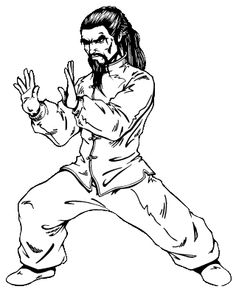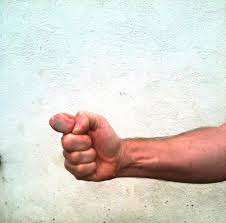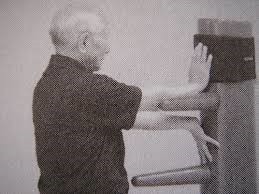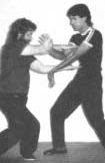Today I thought I would look at several techniques where both hands apparently strike at the same time.
The targets and techniques given in this article are potentially lethal. They are only to be used in life-or-death situations.
The first technique will be familiar from my book. It is “arn” from Tai Chi. “Arn” means “press” but is often translated as “push”. Indeed, it does look like you are trying to push something. One of the maxims of Tai Chi is that you should never be “double weighted”. You should never have your weight equally distributed between your feet and your hands should never be equally yin or yang. Arn seems to violate this principle. The common explanation is that arn is in reality two palm-strikes arriving in quick succession. The hands are hitting rather than pressing or pushing, and one strikes just before another.

Arn can be a powerful attacking technique. In a frontal attack the hands strike the dim-mak points around the pectoral muscles or use the springiness of the foe’s own ribs to bounce him away. As I have said before, this is a fighting technique that is overlooked by many other styles.
A number of combat styles do not share Tai Chi’s aversion to being double-weighted and include simultaneous striking techniques
Another thing to remember when interpreting forms is that if two hands are doing the same thing in a form that is not necessarily how they are intended to be used in combat. A form may have, say, double spear-hands but in reality one spear-hand would be a feint while the other hand was used to parry or readied for a more powerful follow-up.


The second technique we will look at comes from Chuka, phoenix-eye fist. Both hands are held palm upward in phoenix-eye configuration. The wrists or forearms are crossed, the lead hand being underneath. Both hands punch at once, the hands rotating palm down. The lead hand strikes low, the rear hand high. I regard phoenix-eye and one-knuckle fist as soft-tissue weapons so primary targets will be above the suprasternal notch and below the xiphoid process. The xiphoid/ solar plexus region and a palm-width below the navel is another pairing.
A similar simultaneous attack is the double-dragon palms, sometimes called butterfly-palms. This is a double-palm strike with one hand above the other. The upper hand has its fingers up, the lower hand fingers down. This can be used on the same targets as double phoenix-eye punches. Palm strikes are a weapon for both hard or soft body areas so this technique can also be used directly against points on the sternum such as between the nipples or the sternal angle.

If you are using both hands to attack it implies that you have less need to parry or control. Such attacks are therefore a more likely option when on the outside gate. So far we have considered frontal attacks. How might the above techniques be targeted if to the side of an enemy?
Double palm strike (po pai and other spelling variations) is used several times in Wing chun’s advanced-level wooden man form. Palm striking is rather common in this form, in contrast to the snap punches used in earlier forms. Wing chun students may like to ponder why this is so.

The last technique returns us to Tai Chi. It is shown in “How to use Tai Chi as a Fighting Art” by Erle Montaigue and is used as a counter to double dragon-palms. One hand is held above the other, palms flat and fingers towards the enemy. The hands come in from the side to push the dragon palms off course. The finger tips then thrust forwards to attack the body beyond.